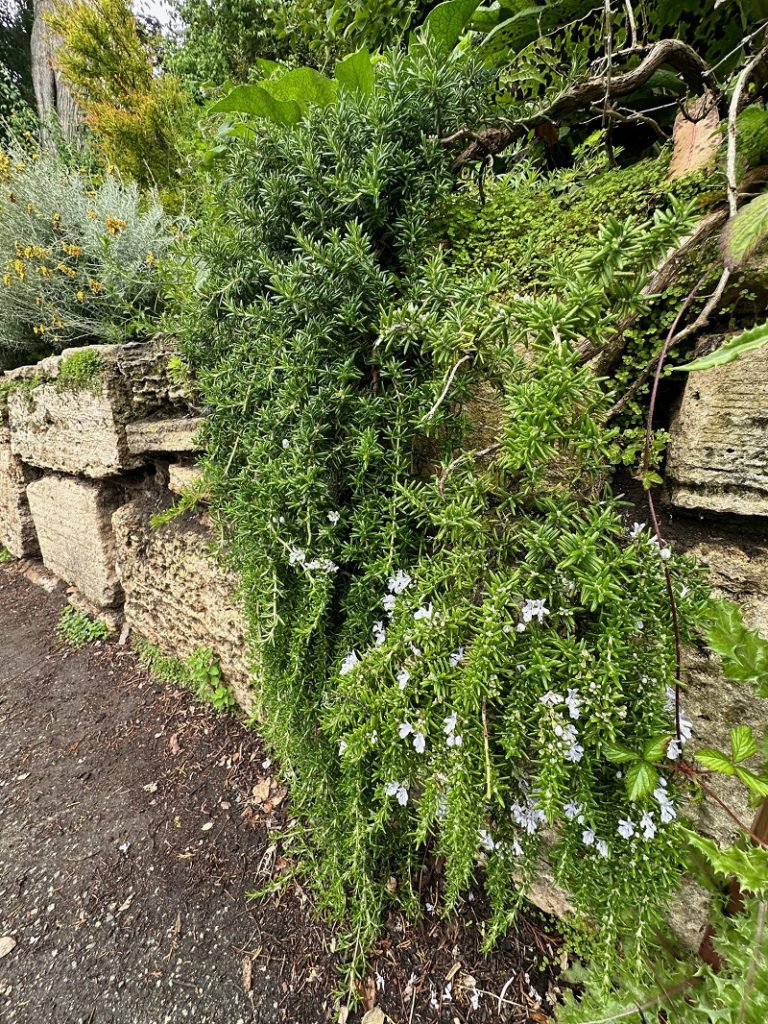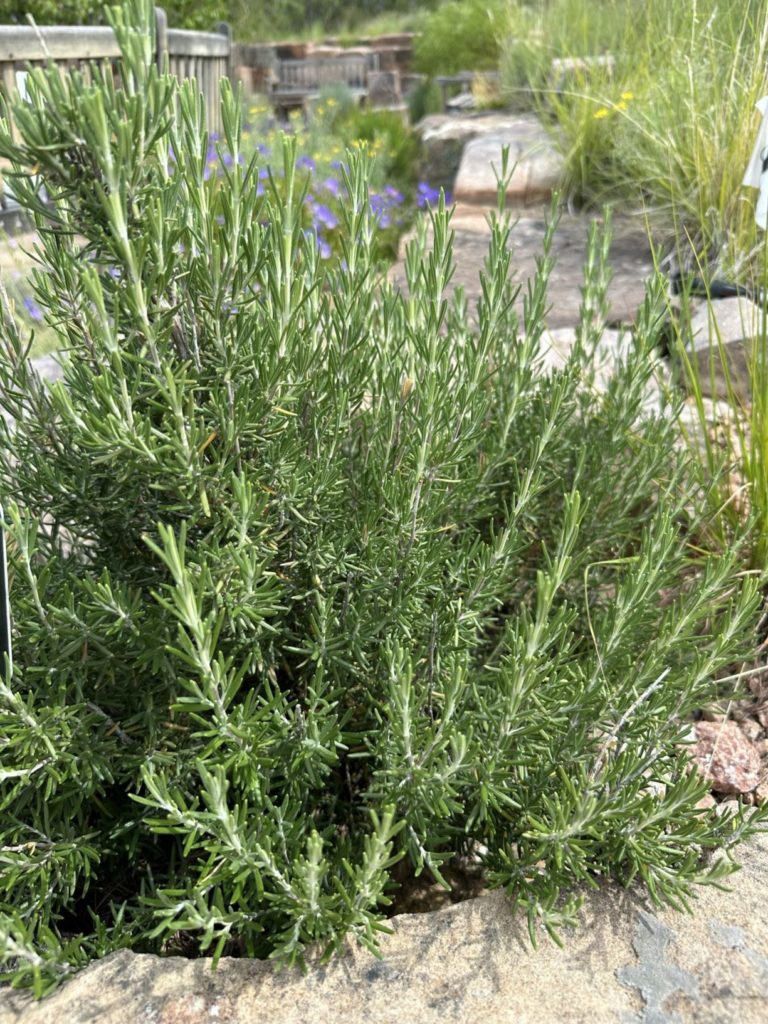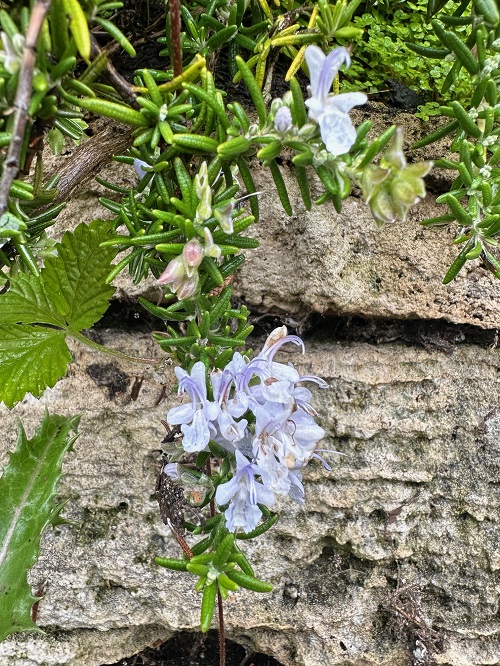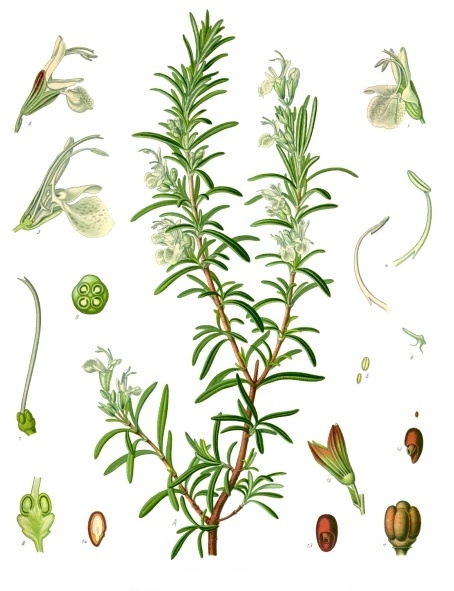Scientific name: Salvia rosmarinus ‘Arp’
Common name: ‘Arp’ rosemary, ‘Arp’ rosmarinus, romero ‘Arp’
Family: Lamiaceae (Mint)
Hardiness: USDA Zone 6 (-10 to 0 °F)
Life form: Shrub/sub-shrub
Article by Eva Maria Räpple
Rosemary is native to the Mediterranean region, southern Europe and North Africa. The Latin Rosmarinus means “dew of the sea” aptly describing a plant that especially thrives on sea cliffs in coastal areas. It can also tolerate colder climates. The fragrant evergreen herb has been used in gardens throughout Northern Europe since the 16th century, frequently overwintering in containers. Settlers brought it to the Americas in the beginning of the 17th century

Rosemary in San Francisco Botanical Garden. Photo: Eva Maria Räpple
Growing Conditions:
‘Arp’ thrives in loose, well-drained, neutral to slightly acidic soils. It can be grown in dry to medium moisture but will die with too much water in winter. It performs poorly in heavy clay soils. It is drought tolerant once established; however, will require regular watering if grown in containers. It performs best in full sun but will tolerate light shade. ‘Arp’ is more cold tolerant than other rosemary cultivars and usually overwinters in Santa Fe. It needs little care but may be fertilized lightly in spring. Plants may be pruned to encourage dense foliage growth or to create specific shapes. Propagation is usually by cuttings.[1] The strong fragrance of rosemary is an excellent repellent for garden pests such as carrot flies and Japanese beetles. Hence, rosemary can be an important companion plant in vegetable gardens. The woody herb with spikes of lightly-scented blue flowers appearing in late spring to early summer is an essential addition to the herb garden. In climates with cold winters, it requires space that offers some shelter and the plant will benefit from a layer of mulch around the root zone. Among the many varieties of rosemary, ‘Arp’ is the most cold hardy and best suited rosemary for Santa Fe’s mountainous winters.

Salvia rosmarinus ‘Arp’ in the Orchard Gardens at Santa Fe Botanical Garden. Photo: Cristina Salvador.
Cultural Significance
As early as the 5th millennium BCE, Sumerian stone tablets contain references to rosemary.[2] The plant was highly valued throughout antiquity for its culinary and medicinal uses but even more importantly as a symbol for love, fertility, and remembrance. It frequently was used during rituals of death due to its pungent scent which was believed to disperse demonic spirits. In ancient Egypt, rosemary was applied in the embalming procedures of pharaohs, and plants were added to tombs.[3] Evergreens like rosemary were often woven into garlands, used as decorations in the house and during festive occasions. Offerings of rosemary branches for the gods were common custom in Greece and Rome.[4] Rosemary appears frequently in writings since the second half of the 15th century, continuing the emphasis on the symbolic as well as medicinal qualities. It served, among other usages, as incense in churches and hospitals believed to purify the air and as perfume. Well documented are also medieval recipes to extract its healing properties.[5]

Rosemary flower in San Francisco Botanical Garden. Photo by Eva Maria Räpple.
Medicinal Usage
The long history of sourcing rosemary’s healing properties carries on today. Research continues to validate and use rosemary (Salvia rosmarinus) for its medical properties.[6] Rosemary’s high antioxidant content can relieve inflammation and pain caused by arthritis if applied as an oil or slave over affected areas.[7] It has significant wound healing properties. Extracts of rosemary and lemon taken internally over a couple of weeks have been successfully shown to decrease harmful effects of UV rays.[8] Salvia rosmarinus carries antioxidant, antimicrobial, antiproliferative properties that possibly can enhance chemotherapeutic cancer medication.[9] Polyphenols in rosemary provide anti-inflammatory and anti-bacterial agents to ease digestion and counteract intestinal issues.[10] Accordingly, it makes sense that rosemary has long been used as an herb paired with fatty meats like lamb.

Köhler’s Medicinal Plants, Hermann Adolph Köhler. Illustrator(s): L. Mueller and C. F. Schmidt. Wikimedia Commons.
Culinary Herb
Fresh or dried, rosemary provides aromatic, pungent flavors reminiscent of pine, mint, and citrus in the kitchen. Just adding the herb to a marinade or placing fresh springs on top of or into small slits of meats like lamb, chicken or game while roasting, releases its robust flavors. Vegetables, soups and breads can use the subtle rosemary flavors and minced fresh rosemary, thyme, roasted tomatoes, olives, and anchovies can be made into a delicious tapenade. Rosemary can also be added to sweets such as apple, pumpkin pie or chocolate cake and, perhaps surprisingly, adds an interesting aroma to citrus fruits.
Although not a native plant, the evergreen herb used to decorate Aphrodite’s head in Ancient Greece, with its small flowers and strong fragrance, can be a beautiful addition to Santa Fe gardens today.
References:
[1] “Salvia rosmarinus ‘Arp'”. Garden Explorer. Santa Fe Botanical Garden, accessed July. 19, 2024. https://santafebotanicalgarden.gardenexplorer.org /.
[2] B. Sasikumar, “Rosemary,” in: K.V. Peter ed. Woodhead Publishing Series in Food, Science, Technology and Nutrition, Handbook of Herbs and Spices. (Woodhead Publishing 2012, 2nd.ed.): 452-68.
[3] V. Kumar et. al. “Herbs: Composition and Dietary Importance” In: B. Caballero et el. eds. Encyclopedia of Food and Health. (Elesvier LTD Academic Press, 2016)
[4] e.g. Horaz, Carmina III, 23.
[5] V. Zimmermann, “Der Rosmarin als Heilpflanze und Wunderdroge: Beitrag zu den mittelalterlichen Drogenmonographien,” Sudhoffs Archive 4 Bd. H. 4 (1980)4. Quarterly): 360-61.
[6] Heinrich Marzel, Unsere Heilpflanzenihre Geschichte und ihre Stellung in der Volkskunde. (Freiburg/Br. 1922), 134-140.
[7] Daniel Lukaczer, et. al. “A Pilot Trial. Evaluatingmeta050, a Proprietary. Combination of Reduced Iso-Alpha. Acids, Rosemary Extract and Olenolic Acid in Patients with Arthritis and Fibromyalgia.” Phytotherapy Research 19, no. 10 (2005)864-869.doi:10.1002/ptr.1709.
[8] A. Pérez-Sánchez, et. el. ” Protective Effects of Citrus and Rosemary Extracts on UV-Induced damage in Skin Cell Model and Human Volunteers.” Journal of Photochemistry and Photobiology B: Biology 136 (July 5, 2014) : 12-18. doi:10.1016/j.jphotobiol.2014.04.007.
[9] Raad, Chris, Abby Raad, and Siyaram Pandey. 2024. “Green Tea Leaves and Rosemary Extracts Selectively Induce Cell Death in Triple-Negative Cancer Cells and Cancer Stem Cells and Enhance the Efficacy of Common Chemotherapeutics.” Evidence-Based Complementary. & Alternative Medicine (ECAM), January -21. Doi:10.1155/2024/9458716.
[10] Lianhua Zhang, Jie Lu. “Rosemary (Rosmarinus officinalis L.) polyphenols and inflammatory bowel diseases: Major phytochemicals, functional properties, and health effects.” Fitoterapia 177. (September 2024). doi.org/10.1016/106074.


